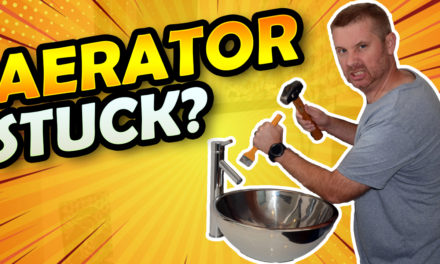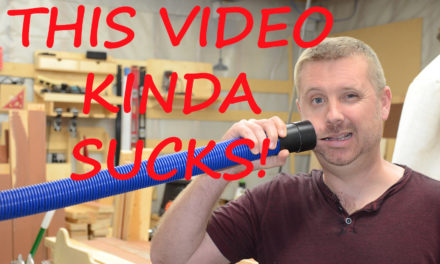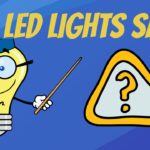Tools Needed
- Screwdriver (slotted or Philips depending on your fixture)
- Wire stripper (these self adjusting strippers are nice!)
- Side cutter or diagonal cutter
Note: As an Amazon Associate I earn from qualifying purchases.

Materials Needed:
- Wire nuts or push-in wire connectors
- LED light tubes
LED Conversion is Getting Easier
In 2017, I posted a video on how to easily convert fluorescent lights to LED. That video has over 2.6MM views and is still going strong. While it’s still a very useful video, things have changed since filming that four years ago and I’ve discovered a new LED tube that is a total game changer. In this video, I’m going to introduce you to a new type of LED T8 tube, tell you why this is the best type of tube to use, and if you choose to rewire your fixture for your LED conversion, I’ll show how to easily bypass the ballast.
Hybrid LED Tubes to the Rescue
Thanks to new hybrid type LED tubes, a fluorescent to LED conversion is far simpler than it was four years ago and this product gives you options. You can literally use this on any fluorescent fixture even the ones you may have already converted to LED. I’ll explain how this T8 replacement tube can be used in three different types of fixtures. At the end, I’m going to demonstrate how to bypass the ballast on a two bulb fixture to work with a double ended tube. But don’t worry about that mouthful, that step is entirely optional. If you want to skip ahead to the rewiring, please scroll down to the appropriate section.
The Old Way to Perform an LED Conversion
Let’s do a quick recap out of the original video so I can point out the criticisms and then cover how this tube solves all those problems. In 2016, most tubes were single ended tubes this means power was delivered to only one end of the tube and that the fluorescent ballast had to be either removed or bypassed. So we had to take our fixture apart, then remove the ballast, then change the lampholders (aka tombstones) that hold the tube in place and then finally connect those tombstones correctly to our house wiring.
The obvious criticisms of that video are:
- Takes too much work
- Rewiring is too complicated
- Too time consuming (why not just buy a new fixture?)
I agree with all those criticisms, but I firmly believe that bypassing the ballast is very important when you convert to LED for two reasons.
- Ballasts waste electricity. Not much but they are power consumers.
- Ballasts will fail. You will have to rewire when they do fail so I say bypass and never worry about it again. However, with this tube it’s your choice.
How Hybrid LED Tubes Work and Why They are Superior
The LED tube in this video is the Parmida Hybrid Type A + Type B Light Tube, part number FBA_PLED-T8-PARMIDA-4FT. Here’s how this tube works and why it is the one size fits all LED retrofit tube.
- This is a type A + type B LED tube. Type A means requires a ballast this are called plug-n-play tubes. Take out fluorescent tubes and put these in. Type B means the ballast must be bypassed. Add the two together and you have options. You can just replace your fluorescent and then if the ballast ever fails, just bypass it and put this tube right back in. One caveat to all type A LED tubes or ballast compatible tubes is that they may not work with all ballasts. Many have a compatibility chart so you might want to check the chart and your ballast if you don’t’ plan on bypassing.
- If you decide to bypass you have a decision to make, do you want single ended (SEP) or double ended power (DEP? My first LED conversion video demonstrated how to rewire a fixture for single ended power. This is the most work since you have to replace the tombstones. Double ended is less work. The best thing about these tubes is they will work in either configuration. Yep, you heard that right. It works with or without a ballast, it works with a single or double ended power configuration.
Compatible Light Fixtures
Since this LED tube is a hybrid tube that be powered either single ended or double ended, it can be used in these three fixtures:
- Standard T8 fluorescent fixture. Any fixture currently using T8 fluorescent bulbs.
- Fluorescent fixture where the ballast has been bypassed. This configuration is typically a double ended power connection.
- Fluorescent fixture that has been converted for single ended LED tubes.
So if you followed the steps in my first video, you can still use this tube in those single ended fixtures as well. You can comfortably purchase these and use them in any fixture – fluorescent or LED. I have a link in the materials list above for this specific tube. I’m sure there are multiple manufacturers so if you want to shop around look for a type A + type B tube that accepts single-ended and double-ended connections.
How To Bypass the Ballast
The easiest way to do this is watch the video! But here is a summary of the steps.
- Shut off the circuit breaker for the circuit with your fluorescent light. Very important!
- Remove the existing fluorescent bulbs.
- Remove the ballast cover (usually between the bulbs or under them).
- Disconnect the ballast from the house wiring. Typically there will be two screw nuts one on the black wire (hot) and one on the white wire (neutral). Unscrew those to separate the wires.
- For all other wires coming out of the ballast, cut those off as close to the ballast as possible.
- Now, choose which end will be hot and which end will be neutral.
- Take all the wires coming from one end of the fixture and twist them together with either the hot or neutral wire house wires (not both!).
- Repeat the above step with the wires on the other end.
- Install one LED tube and turn the power back on. Test before you reinstall the ballast cover and install the remaining tubes.
That’s all there is to it. One other piece of advice, I recommend placing a sticker on a converted fixture just to let others know that this has been rewired and will no longer accept fluorescent tubes.








